Projecting the CO2 and Climatic Change Effects on the Net Primary Productivity of the Urban Ecosystems in Phoenix, AZ in the 21st Century under Multiple RCP (Representative Concentration Pathway) Scenarios
Abstract
:1. Introduction
2. Materials and Methods
2.1. Study Area
2.2. Model Description
2.3. Input Data Description
2.4. Experimental Design and Factorial Analysis
3. Results
3.1. Temporal Change Pattern of NPP
3.2. Relative Contributions of Environmental Factors to NPP Changes
3.3. Spatial Variation in NPP and the Responses from Different Ecosystem Types
4. Discussion
5. Conclusions
Acknowledgments
Author Contributions
Conflicts of Interest
References
- Reeves, M.C.; Moreno, A.L.; Bagne, K.E.; Running, S.W. Estimating climate change effects on net primary production of rangelands in the United States. Clim. Chang. 2014, 126, 429–442. [Google Scholar] [CrossRef]
- Xu, X.; Tan, Y.; Yang, G.; Li, H.; Su, W. Impacts of China’s Three Gorges Dam Project on net primary productivity in the reservoir area. Sci. Total Environ. 2011, 409, 4656–4662. [Google Scholar] [CrossRef] [PubMed]
- Beer, C.; Reichstein, M.; Tomelleri, E.; Ciais, P.; Jung, M.; Carvalhais, N.; Rödenbeck, C.; Arain, M.A.; Baldocchi, D.; Bonan, G.B.; et al. Terrestrial Gross Carbon Dioxide Uptake: Global Distribution and Covariation with Climate. Science 2010, 329, 834–838. [Google Scholar] [CrossRef] [PubMed]
- Feng, X.; Liu, G.; Chen, J.M.; Chen, M.; Liu, J.; Ju, W.M.; Sun, R.; Zhou, W. Net primary productivity of China’s terrestrial ecosystems from a process model driven by remote sensing. J. Environ. Manag. 2007, 85, 563–573. [Google Scholar] [CrossRef] [PubMed]
- Vackar, D.; Orlitova, E. Human appropriation of aboveground photosynthetic production in the Czech Republic. Reg. Environ. Chang. 2011, 11, 519–529. [Google Scholar] [CrossRef]
- Wu, J. Urban ecology and sustainability: The state-of-the-science and future directions. Landsc. Urban Plan. 2014, 125, 209–221. [Google Scholar] [CrossRef]
- Lazzarini, M.; Molini, A.; Marpu, P.R.; Ouarda, T.B.M.J.; Ghedira, H. Urban climate modifications in hot desert cities: The role of land cover, local climate, and seasonality. Geophys. Res. Lett. 2015, 42, 9980–9989. [Google Scholar] [CrossRef]
- Wu, J. Landscape sustainability science: Ecosystem services and human well-being in changing landscapes. Landsc. Ecol. 2013, 28, 999–1023. [Google Scholar] [CrossRef]
- Shen, W.; Wu, J.; Grimm, N.B.; Hope, D. Effects of Urbanization-Induced Environmental Changes on Ecosystem Functioning in the Phoenix Metropolitan Region, USA. Ecosystems 2008, 11, 138–155. [Google Scholar] [CrossRef]
- Hua, L.Z.; Liu, H.; Zhang, X.L.; Zheng, Y.; Man, W.; Yin, K. Estimation Terrestrial Net Primary Productivity Based on CASA Model: A Case Study in Minnan Urban Agglomeration, China. In IOP Conference Series: Earth and Environmental Science; IOP Publishing: Bristol, UK, 2014; Volume 17. [Google Scholar]
- Shields, C.; Tague, C. Ecohydrology in semiarid urban ecosystems: Modeling the relationship between connected impervious area and ecosystem productivity. Water Resour. Res. 2015, 51, 302–319. [Google Scholar] [CrossRef]
- Yu, D.; Shao, H.B.; Shi, P.J.; Zhu, W.Q.; Pan, Y.Z. How does the conversion of land cover to urban use affect net primary productivity? A case study in Shenzhen city, China. Agric. For. Meteorol. 2009, 149, 2054–2060. [Google Scholar]
- Elmore, A.J.; Shi, X.; Gorence, N.J.; Li, X.; Jin, H.; Wang, F.; Zhang, X. Spatial distribution of agricultural residue from rice for potential biofuel production in China. Biomass Bioenergy 2008, 32, 22–27. [Google Scholar] [CrossRef]
- Schneider, A.; Logan, K.E.; Kucharik, C.J. Impacts of urbanization on ecosystem goods and services in the u.s. corn belt. Ecosystems 2012, 15, 519–541. [Google Scholar] [CrossRef]
- Zhao, S.Q.; Liu, S.G.; Zhou, D.C. Prevalent vegetation growth enhancement in urban environment. Proc. Natl. Acad. Sci. USA 2016, 113, 6313–6318. [Google Scholar] [CrossRef] [PubMed]
- Fu, Y.C.; Lu, X.Y.; Zhao, Y.L.; Zeng, X.T.; Xia, L.L. Assessment impacts of weather and land use/land cover (lulc) change on urban vegetation net primary productivity (npp): A case study in Guangzhou, China. Remote Sens. 2013, 5, 4125–4144. [Google Scholar] [CrossRef]
- Pei, F.S.; Li, X.; Liu, X.P.; Lao, C.H.; Xia, G.R. Exploring the response of net primary productivity variations to urban expansion and climate change: A scenario analysis for Guangdong Province in China. J. Environ. Manag. 2015, 150, 92–102. [Google Scholar] [CrossRef] [PubMed]
- Imhoff, M.L.; Bounoua, L.; DeFries, R.; Lawrence, W.T.; Stutzer, D.; Tucker, C.J.; Ricketts, T. The consequences of urban land transformation on net primary productivity in the United States. Remote Sens. Environ. 2004, 89, 434–443. [Google Scholar] [CrossRef]
- Arneth, A.; Harrison, S.P.; Zaehle, S.; Tsigaridis, K.; Menon, S.; Bartlein, P.J.; Feichter, J.; Korhola, A.; Kulmala, M.; O’Donnell, D.; et al. Terrestrial biogeochemical feedbacks in the climate system. Nat. Geosci. 2010, 3, 525–532. [Google Scholar] [CrossRef]
- Morales, P.; Sykes, M.T.; Prentice, I.C.; Smith, P.; Smith, B.; Bugmann, H.; Zierl, B.; Friedlingstein, P.; Viovy, N.; Sabate, S.; et al. Comparing and evaluating process-based ecosystem model predictions of carbon and water fluxes in major European forest biomes. Glob. Chang. Biol. 2005, 11, 2211–2233. [Google Scholar] [CrossRef]
- Zhang, C.; Wu, J.; Grimm, N.B.; McHale, M.; Buyantuyev, A. A hierarchical patch mosaic ecosystem model for urban landscapes: Model development and evaluation. Ecol. Model. 2013, 250, 81–100. [Google Scholar] [CrossRef]
- Wu, J.; Jenerette, G.D.; David, J.L. Linking Land-use Change with Ecosystem Processes: A Hierarchical Patch Dynamic Model. In Integrated Land Use and Environmental Models; Springer: Berlin/Heidelberg, Germany, 2003; pp. 99–119. [Google Scholar]
- Wu, J. Hierarchy and scaling: Extrapolating information along a scaling ladder. Can. J. Remote Sens. 1999, 25, 367–380. [Google Scholar] [CrossRef]
- Wu, J.; David, J.L. A spatially explicit hierarchical approach to modeling complex ecological systems: Theory and applications. Ecol. Model. 2002, 153, 7–26. [Google Scholar] [CrossRef]
- Groffman, P.M.; Pouyat, R.V.; Cadenasso, M.L.; Zipperer, W.C.; Szlavecz, K.; Yesilonis, I.D.; Band, L.E.; Brush, G.S. Land use context and natural soil controls on plant community composition and soil nitrogen and carbon dynamics in urban and rural forests. For. Ecol. Manag. 2006, 236, 177–192. [Google Scholar] [CrossRef]
- Niemelä, J. Is there a need for a theory of urban ecology? Urban Ecosyst. 1999, 3, 57–65. [Google Scholar] [CrossRef]
- Farquhar, G.; Caemmerer, S.; Berry, J. A biochemical model of photosynthetic CO2 assimilation in leaves of C 3 species. Planta 1980, 149, 78–90. [Google Scholar] [CrossRef] [PubMed]
- Collatz, G.; Ribas-Carbo, M.; Berry, J. Coupled photosynthesis-stomatal conductance model for leaves of C4 plants. Aust. J. Plant Physiol. 1992, 19, 519. [Google Scholar] [CrossRef]
- Bonan, G.B. A Land Surface Model (LSM Version 1.0) for Ecological, Hydrological, and Atmospheric Studies: Technical Description and User’s Guide; National Center for Atmospheric Research: Boulder, CO, USA, 1996. [Google Scholar]
- Sellers, P.; Bounoua, L.; Collatz, G. Comparison of radiative and physiological effects of doubled atmospheric CO2 on climate. Science 1996, 271, 1402–1405. [Google Scholar] [CrossRef]
- Friend, A.; Stevens, A.; Knox, R.; Cannell, M. A Process-Based, Terrestrial biosphere model of ecosystem dynamics (Hybrid v3. 0). Ecol. Modell. 1997, 95, 249–287. [Google Scholar] [CrossRef]
- Ryan, M. Effects of climate change on plant respiration. Ecol. Appl. 1991, 1, 157–167. [Google Scholar] [CrossRef] [PubMed]
- Baker, L.A.; Hope, D.; Xu, Y.; Edmonds, J.; Lauver, L. Nitrogen balance for the central arizona-phoenix (cap) ecosystem. Ecosystems 2001, 4, 582–602. [Google Scholar] [CrossRef]
- Lohse, K.A.; Hope, D.; Sponseller, R.; Allen, J.O.; Grimm, N.B. Atmospheric deposition of carbon and nutrients across an arid metropolitan area. Sci. Total Environ. 2008, 402, 95–105. [Google Scholar] [CrossRef] [PubMed]
- Grimm, N.; Earl, S.; Anderson, J.; Fernando, H.; Grossman-Clarke, S.; Stefanov, W.; Hope, D.; Zehnder, J.; Hyde, P. Long-Term Monitoring of Atmospheric Deposition in Central Arizona-Phoenix, Ongoing Since 1999. Available online: https://sustainability.asu.edu/caplter/data/data-catalog/view/knb-lter-cap.23.12/ (accessed on 23 June 2017).
- Taylor, K.E.; Stouffer, R.J.; Meehl, G.A.; Taylor, K.E.; Stouffer, R.J.; Meehl, G.A. An overview of cmip5 and the experiment design. Bull. Am. Meteorol. Soc. 2012, 93, 485–498. [Google Scholar] [CrossRef]
- Rogelj, J.; Meinshausen, M.; Knutti, R. Global warming under old and new scenarios using ipcc climate sensitivity range estimates. Nat. Clim. Chang. 2012, 2, 248–253. [Google Scholar] [CrossRef]
- Pourmokhtarian, A.; Driscoll, C.T.; Campbell, J.L.; Hayhoe, K.; Stoner, A.M.K. The effects of climate downscaling technique and observational data set on modeled ecological responses. Ecol. Appl. 2016, 26, 1321–1337. [Google Scholar] [CrossRef] [PubMed]
- Brekke, L.; Thrasher, B.L.; Maurer, E.P.; Pruitt, T. Downscaled CMIP3 and CMIP5 Climate Projections: Release of Downscaled CMIP5 Climate Projections (LOCA) and Comparison with Preceding Information, and Summary of User Needs; US Department of the Interior, Bureau of Reclamation, Technical Service Center: Denver, CO, USA, 2013; pp. 1–47.
- Pierce, D.W.; Cayan, D.R.; Thrasher, B.L.; Pierce, D.W.; Cayan, D.R.; Thrasher, B.L. Statistical downscaling using localized constructed analogs (LOCA). J. Hydrometeorol. 2014, 15, 2558–2585. [Google Scholar] [CrossRef]
- Pan, S.; Tian, H.; Dangal, S.R.S.; Zhang, C.; Yang, J.; Tao, B.; Ouyang, Z.; Wang, X.; Lu, C.; Ren, W.; et al. Complex spatiotemporal responses of global terrestrial primary production to climate change and increasing atmospheric CO2 in the 21st century. PLoS ONE 2014, 9, e112810. [Google Scholar] [CrossRef] [PubMed]
- Banger, K.; Tian, H.; Tao, B.; Ren, W.; Pan, S.; Dangal, S.; Yang, J. Terrestrial net primary productivity in india during 1901–2010: Contributions from multiple environmental changes. Clim. Chang. 2015, 132, 575–588. [Google Scholar] [CrossRef]
- Bacastow, R.; Keeling, C.; Woodwell, G.; Pecan, E. Atmospheric Carbon Dioxide and Radiocarbon in the Natural Carbon Cycle. II. Changes from ad 1700 to 2070 as Deduced from a Geochemical Model; No. CONF-720510; University of California: San Diego, CA, USA; Brookhaven National Lab.: Upton, NY, USA, 1973. [Google Scholar]
- Johnson, J.K.; Reynolds, S.J.; Jones, D.A. Geologic Map of the Phoenix Mountains, Central Arizona; Arizona Geological Survey: Tucson, AZ, USA, 2003. [Google Scholar]
- Zhu, P.; Zhuang, Q.; Ciais, P.; Welp, L.; Li, W.; Xin, Q. Elevated Atmospheric CO2 Negatively impacts photosynthesis through radiative forcing and physiology-mediated climate feedback. Geophys. Res. Lett. 2017, 44, 1956–1963. [Google Scholar] [CrossRef]
- Mercado, L.M.; Bellouin, N.; Sitch, S.; Boucher, O.; Huntingford, C.; Wild, M.; Cox, P.M. Impact of changes in diffuse radiation on the global land carbon sink. Nature 2009, 458, 1014–1017. [Google Scholar] [CrossRef] [PubMed] [Green Version]
- Huntingford, C.; Cox, P.M.; Mercado, L.M.; Sitch, S.; Bellouin, N.; Boucher, O.; Gedney, N. Highly contrasting effects of different climate forcing agents on terrestrial ecosystem services. Philos. Trans. R. Soc. Lond. A Math. Phys. Eng. Sci. 2011, 369, 2026–2037. [Google Scholar] [CrossRef] [PubMed] [Green Version]
- Zhao, F.; Zeng, N. Continued increase in atmospheric CO2 seasonal amplitude in the 21st century projected by the cmip5 earth system models. Earth Syst. Dyn. 2014, 5, 423–439. [Google Scholar] [CrossRef]
- Norby, R.J.; Delucia, E.H.; Gielen, B.; Calfapietra, C.; Giardina, C.P.; King, J.S.; Ledford, J.; McCarthy, H.R.; Moore, D.J.P.; Ceulemans, R.; et al. Forest response to elevated CO2 is conserved across a broad range of productivity. Proc. Natl. Acad. Sci. USA 2005, 102, 18052–18056. [Google Scholar] [CrossRef] [PubMed]
- Field, C.B.; Jackson, R.B.; Mooney, H.A. Stomatal responses to increased CO2: Implications from the plant to the global scale. Plant Cell Environ. 1995, 18, 1214–1225. [Google Scholar] [CrossRef]
- Alexandrov, G.A.; Oikawa, T.; Yamagata, Y. Climate dependence of the CO2 fertilization effect on terrestrial net primary production. Tellus Ser. B Chem. Phys. Meteorol. 2003, 55, 669–675. [Google Scholar] [CrossRef]
- Fisher, G. How do climate change and bioenergy alter the long-term outlook for food, agricultre and resource availability. In Proceedings of the Expert Meeting on How to Feed the World in 2050, Rome, Italy, 24–26 June 2009. [Google Scholar]
- McGrath, J.M.; Lobell, D.B. Regional disparities in the CO2 fertilization effect and implications for crop yields. Environ. Res. Lett. 2013, 8, 14054. [Google Scholar] [CrossRef]
- Milchunas, D.G.; Mosier, A.R.; Morgan, J.A.; LeCain, D.R.; King, J.Y.; Nelson, J.A. Root production and tissue quality in a shortgrass steppe exposed to elevated CO2: Using a new ingrowth method. Plant Soil 2005, 268, 111–122. [Google Scholar] [CrossRef]
- Niklaus, P.A.; Wohlfender, M.; Siegwolf, R.; Körner, C. Effects of six years atmospheric CO2 enrichment on plant, soil, and soil microbial C of a calcareous grassland. Plant Soil 2001, 233, 189–202. [Google Scholar] [CrossRef]
- Reich, P.B.; Knops, J.; Tilman, D.; Craine, J.; Ellsworth, D.; Tjoelker, M.; Lee, T.; Wedin, D.; Naeem, S.; Bahauddin, D.; et al. Plant diversity enhances ecosystem responses to elevated CO2 and nitrogen deposition. Nature 2001, 410, 809–813. [Google Scholar] [CrossRef] [PubMed]
- Zavalloni, C.; Vicca, S.; Büscher, M.; de la Providencia, I.E.; de Boulois, H.D.; Declerck, S.; Nijs, I.; Ceulemans, R. Exposure to warming and CO2 enrichment promotes greater above-ground biomass, nitrogen, phosphorus and arbuscular mycorrhizal colonization in newly established grasslands. Plant Soil 2012, 359, 121–136. [Google Scholar] [CrossRef]
- Housman, D.C.; Naumburg, E.; Huxman, T.E.; Charlet, T.N.; Nowak, R.S.; Smith, S.D. Increases in desert shrub productivity under elevated carbon dioxide vary with water availability. Ecosystems 2006, 9, 374–385. [Google Scholar] [CrossRef]
- Smith, S.D.; Huxman, T.E.; Zitzer, S.F.; Charlet, T.N.; Housman, D.C.; Coleman, J.S.; Fenstermaker, L.K.; Seemann, J.R.; Nowak, R.S. Elevated CO2 increases productivity and invasive species success in an arid ecosystem. Nature 2000, 408, 79–82. [Google Scholar] [CrossRef] [PubMed]
- Dijkstra, P.; Hymus, G.; Colavito, D.; Vieglais, D.A.; Cundari, C.M.; Johnson, D.P.; Hungate, B.A.; Hinkle, C.R.; Drake, B.G. Elevated atmospheric CO2 stimulates aboveground biomass in a fire-regenerated scrub-oak ecosystem. Glob. Chang. Biol. 2002, 8, 90–103. [Google Scholar] [CrossRef]
- Tognetti, R.; Johnson, J.D. Responses of growth, nitrogen and carbon partitioning to elevated atmospheric CO2 concentration in live oak in relation to nutrient supply. Ann. For. Sci. 1999, 56, 91–105. [Google Scholar] [CrossRef]
- Jach, M.E.; Laureysens, I.; Ceulemans, R. Above- and below-ground production of young Scots pine (Pinus sylvestris L.) trees after three years of growth in the field under elevated CO2. Ann. Bot. 2000, 85, 789–798. [Google Scholar] [CrossRef]
- Rey, A.; Jarvis, P.G. Growth Response of Young Birch Trees (Betula pendulaRoth.) After Four and a Half Years of CO2 Exposure. Ann. Bot. 1997, 80, 809–816. [Google Scholar] [CrossRef]
- Dijkstra, P.; Schapendonk, A.D.H.M.C.; Groenwold, K.O. Seasonal changes in the response of winter wheat to elevated atmospheric CO2 concentration grown in Open-Top Chambers and field tracking enclosures. Glob. Chang. Biol. 1999, 5, 563–576. [Google Scholar] [CrossRef]
- Hebeisen, T.; Luscher, A.; Zanetti, S.; Fischer, B.; Hartwig, U.; Frehner, M.; Hendrey, G.; Blum, H.; Nosberger, J. Growth response of Trifolium repens L. and Lolium perenne L. as monocultures and bi-species mixture to free air CO2 enrichment and management. Glob. Chang. Biol. 1997, 3, 149–160. [Google Scholar] [CrossRef]
- Högy, P.; Keck, M.; Niehaus, K.; Franzaring, J.; Fangmeier, A. Effects of atmospheric CO2 enrichment on biomass, yield and low molecular weight metabolites in wheat grain. J. Cereal Sci. 2010, 52, 215–220. [Google Scholar] [CrossRef]
- Costanza, R.; d’Arge, R.; de Groot, R.; Farber, S.; Grasso, M.; Hannon, B.; Limburg, K.; Naeem, S.; O’Neill, R.V.; Paruelo, J.; et al. The value of ecosystem services: Putting the issues in perspective. Ecol. Econ. 1998, 25, 67–72. [Google Scholar] [CrossRef]
- Costanza, R.; Fisher, B.; Mulder, K.; Liu, S.; Christopher, T. Biodiversity and ecosystem services: A multi-scale empirical study of the relationship between species richness and net primary production. Ecol. Econ. 2007, 61, 478–491. [Google Scholar] [CrossRef]
- Parry, M.; Rosenzweig, C.; Iglesias, A.; Livermore, M.; Fischer, G. Effects of climate change on global food production under SRES emissions and socio-economic scenarios. Glob. Environ. Chang. 2004, 14, 53–67. [Google Scholar] [CrossRef]
- Smith, P.; Gregory, P. Climate change and sustainable food production. Proc. Nutr. Soc. 2013, 72, 21–28. [Google Scholar] [CrossRef] [PubMed]
- Jenerette, G.D.; Harlan, S.L.; Stefanov, W.L.; Martin, C.A. Ecosystem services and urban heat riskscape moderation: Water, green spaces, and social inequality in Phoenix, USA. Ecol. Appl. 2011, 21, 2637–2651. [Google Scholar] [CrossRef] [PubMed]
- Duraiappah, A.K.; Naeem, S.; Agardy, T.; Ash, N.J.; Cooper, H.D.; Díaz, S.; Faith, D.P.; Mace, G.; McNeely, J.A.; Mooney, H.A.; et al. Ecosystems and Human Well-Being; Island Press: Washington, DC, USA, 2005; Volume 5. [Google Scholar]
- Grimm, N.B.; Redman, C.L.; Boone, C.G.; Childers, D.L.; Harlan, S.L.; Turner, B.L. Viewing the Urban Socio-ecological System Through a Sustainability Lens: Lessons and Prospects from the Central Arizona–Phoenix LTER Programme. In Long Term Socio-Ecological Research; Springer: Dordrecht, The Netherlands, 2013; pp. 217–246. [Google Scholar]
- Zhang, C.; Tian, H.; Chen, G.; Chappelka, A.; Xu, X.; Ren, W.; Hui, D.; Liu, M.; Lu, C.; Pan, S.; et al. Impacts of urbanization on carbon balance in terrestrial ecosystems of the Southern United States. Environ. Pollut. 2012, 164, 89–101. [Google Scholar] [CrossRef] [PubMed]
- Zölch, T.; Maderspacher, J.; Wamsler, C.; Pauleit, S. Using green infrastructure for urban climate-proofing: An evaluation of heat mitigation measures at the micro-scale. Urban For. Urban Green. 2016, 20, 305–316. [Google Scholar] [CrossRef]
- Brink, E.; Aalders, T.; Ádám, D.; Feller, R.; Henselek, Y.; Hoffmann, A.; Ibe, K.; Matthey-Doret, A.; Meyer, M.; Negrut, N.L.; et al. Cascades of green: A review of ecosystem-based adaptation in urban areas. Glob. Environ. Chang. 2016, 36, 111–123. [Google Scholar] [CrossRef]
- Smart, J.C.R.; Hicks, K.; Morrissey, T.; Heinemeyer, A.; Sutton, M.A.; Ashmore, M. Applying the ecosystem service concept to air quality management in the UK: A case study for ammonia. Environmetrics 2011, 22, 649–661. [Google Scholar] [CrossRef]
- Tiwary, A.; Kumar, P. Impact evaluation of green–grey infrastructure interaction on built-space integrity: An emerging perspective to urban ecosystem service. Sci. Total Environ. 2014, 487, 350–360. [Google Scholar] [CrossRef] [PubMed] [Green Version]
- Teague, A.; Russell, M.; Harvey, J.; Dantin, D.; Nestlerode, J.; Alvarez, F. A spatially-explicit technique for evaluation of alternative scenarios in the context of ecosystem goods and services. Ecosyst. Serv. 2016, 20, 15–29. [Google Scholar] [CrossRef]
- Luo, Y.; Wan, S.; Hui, D.; Wallace, L.L. Acclimatization of soil respiration to warming in a tall grass prairie. Nature 2001, 413, 622–625. [Google Scholar] [CrossRef] [PubMed]
- Koerner, B.; Klopatek, J. Anthropogenic and natural CO2 emission sources in an arid urban environment. Environ. Pollut. 2002, 116, S45–S51. [Google Scholar] [CrossRef]
- Grimm, N.B.; Faeth, S.H.; Golubiewski, N.E.; Redman, C.L.; Wu, J.; Bai, X.; Briggs, J.M. Global Change and the Ecology of Cities. Science 2008, 319, 756–760. [Google Scholar] [CrossRef] [PubMed]
- Yospin, G.I.; Bridgham, S.D.; Neilson, R.P.; Bolte, J.P.; Bachelet, D.M.; Gould, P.J.; Harrington, C.A.; Kertis, J.A.; Evers, C.; Johnson, B.R. A new model to simulate climate-change impacts on forest succession for local land management. Ecol. Appl. 2015, 25, 226–242. [Google Scholar] [CrossRef] [PubMed]
- Keane, R.E.; Cary, G.J.; Flannigan, M.D.; Parsons, R.A.; Davies, I.D.; King, K.J.; Li, C.; Bradstock, R.A.; Gill, M. Exploring the role of fire, succession, climate, and weather on landscape dynamics using comparative modeling. Ecol. Modell. 2013, 266, 172–186. [Google Scholar] [CrossRef]
- Wimberly, M.C.; Liu, Z. Interactions of climate, fire, and management in future forests of the Pacific Northwest. For. Ecol. Manag. 2014, 327, 270–279. [Google Scholar] [CrossRef]
- McDowell, W.G.; Benson, A.J.; Byers, J.E. Climate controls the distribution of a widespread invasive species: Implications for future range expansion. Freshw. Biol. 2014, 59, 847–857. [Google Scholar] [CrossRef]
- Barney, J.N.; DiTomaso, J.M. Bioclimatic predictions of habitat suitability for the biofuel switchgrass in North America under current and future climate scenarios. Biomass Bioenergy 2010, 34, 124–133. [Google Scholar] [CrossRef]
- Loss, S.R.; Terwilliger, L.A.; Peterson, A.C. Assisted colonization: Integrating conservation strategies in the face of climate change. Biol. Conserv. 2011, 144, 92–100. [Google Scholar] [CrossRef]
- Chown, S.L.; Huiskes, A.H.L.; Gremmen, N.J.M.; Lee, J.E.; Terauds, A.; Crosbie, K.; Frenot, Y.; Hughes, K.A.; Imura, S.; Kiefer, K.; et al. Continent-wide risk assessment for the establishment of nonindigenous species in Antarctica. Proc. Natl. Acad. Sci. USA 2012, 109, 4938–4943. [Google Scholar] [CrossRef] [PubMed]
- Elith, J.; Kearney, M.; Phillips, S. The art of modelling range-shifting species. Methods Ecol. Evol. 2010, 1, 330–342. [Google Scholar] [CrossRef]
- Zhang, C.; Tian, H.; Pan, S.; Lockaby, G. Multi-factor controls on terrestrial carbon dynamics in urbanized areas. Biogeosciences 2014, 11, 7107. [Google Scholar] [CrossRef]
- Roy, S.; Byrne, J.; Pickering, C. A systematic quantitative review of urban tree benefits, costs, and assessment methods across cities in different climatic zones. Urban For. Urban Green. 2012, 11, 351–363. [Google Scholar] [CrossRef]
- Von Döhren, P.; Haase, D. Ecosystem disservices research: A review of the state of the art with a focus on cities. Ecol. Indic. 2015, 52, 490–497. [Google Scholar] [CrossRef]
- Escobedo, F.J.; Kroeger, T.; Wagner, J.E. Urban forests and pollution mitigation: Analyzing ecosystem services and disservices. Environ. Pollut. 2011, 159, 2078–2087. [Google Scholar] [CrossRef] [PubMed]
- Obermeier, W.A.; Lehnert, L.W.; Kammann, C.I.; Muller, C.; Grunhage, L.; Luterbacher, J.; Erbs, M.; Moser, G.; Seibert, R.; Yuan, N.; et al. Reduced CO2 fertilization effect in temperate C3 grasslands under more extreme weather conditions. Nat. Clim. Chang. 2017, 7, 137–141. [Google Scholar] [CrossRef]
- Tubby, K.V.; Webber, J.F. Pests and diseases threatening urban trees under a changing climate. Forestry 2010, 83, 451–459. [Google Scholar] [CrossRef]
- Ordonez, C.; Duinker, P.N. Climate change vulnerability assessment of the urban forest in three Canadian cities. Clim. Chang. 2015, 131, 531–543. [Google Scholar] [CrossRef]
- Ciais, P.; Reichstein, M.; Viovy, N.; Granier, A.; Ogée, J. Europe-wide reduction in primary productivity caused by the heat and drought in 2003. Nature 2005, 437, 529. [Google Scholar] [CrossRef] [PubMed]
- Ainsworth, E.A.; Long, S.P. What have we learned from 15 years of free-air CO2 enrichment (FACE)? A meta-analytic review of the responses of photosynthesis, canopy properties and plant production to rising CO2. New Phytol. 2004, 165, 351–372. [Google Scholar] [CrossRef] [PubMed]
- Schlenker, W.; Lobell, D.B. Robust negative impacts of climate change on African agriculture. Environ. Res. Lett. 2010, 5, 14010. [Google Scholar] [CrossRef]
- Terrer, C.; Vicca, S.; Hungate, B.A.; Phillips, R.P.; Prentice, I.C. Mycorrhizal association as a primary control of the CO2 fertilization effect. Science 2016, 353, 72–74. [Google Scholar] [CrossRef] [PubMed]
- Poland, T.M.; McCullough, D.G. Emerald ash borer: Invasion of the urban forest and the threat to North America’s ash resource. J. For. 2006, 104, 118–124. [Google Scholar]
- Wallach, D.; Mearns, L.O.; Ruane, A.C.; Rotter, R.P.; Asseng, S. Lessons from climate modeling on the design and use of ensembles for crop modeling. Clim. Chang. 2016, 139, 551–564. [Google Scholar] [CrossRef]
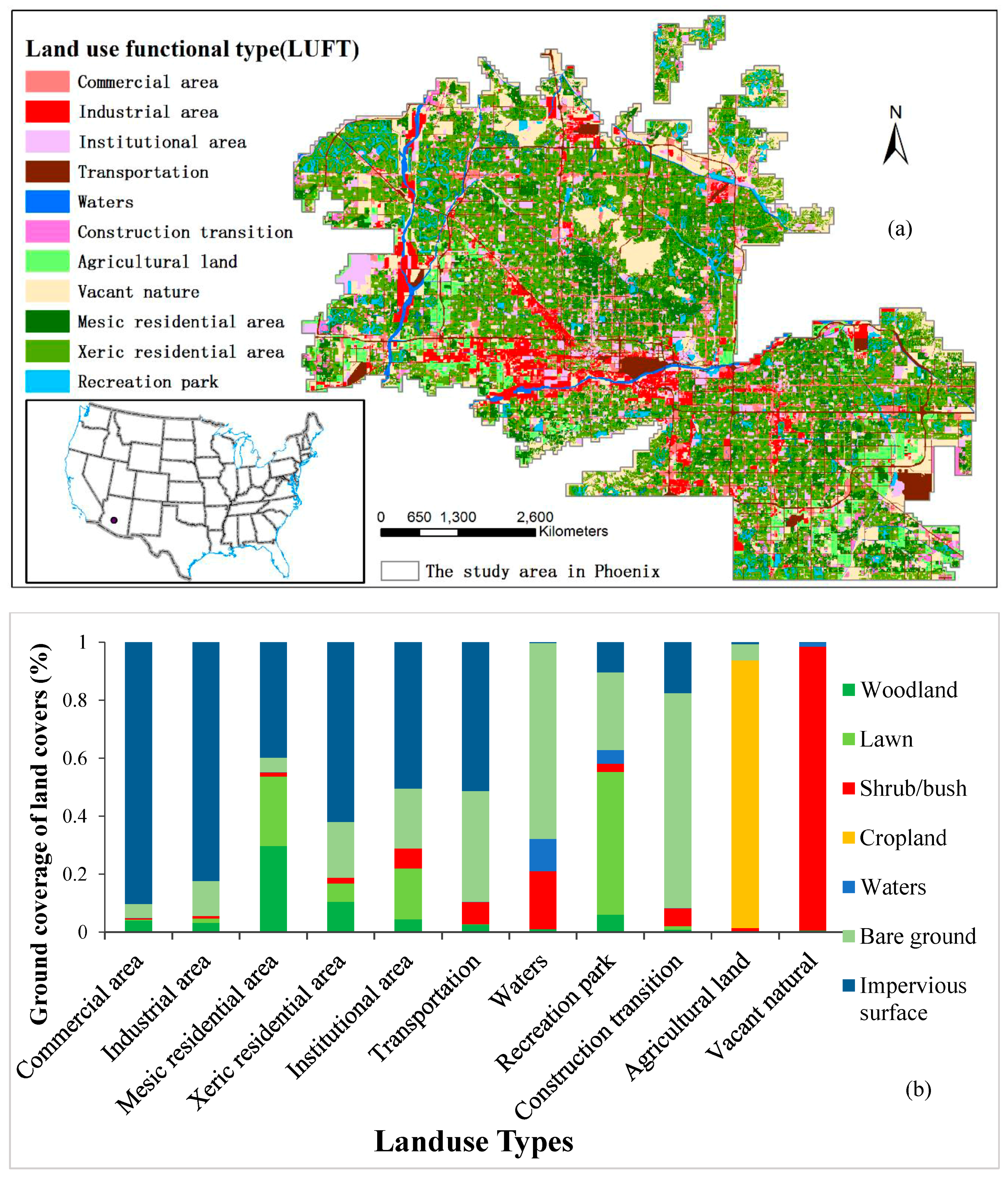
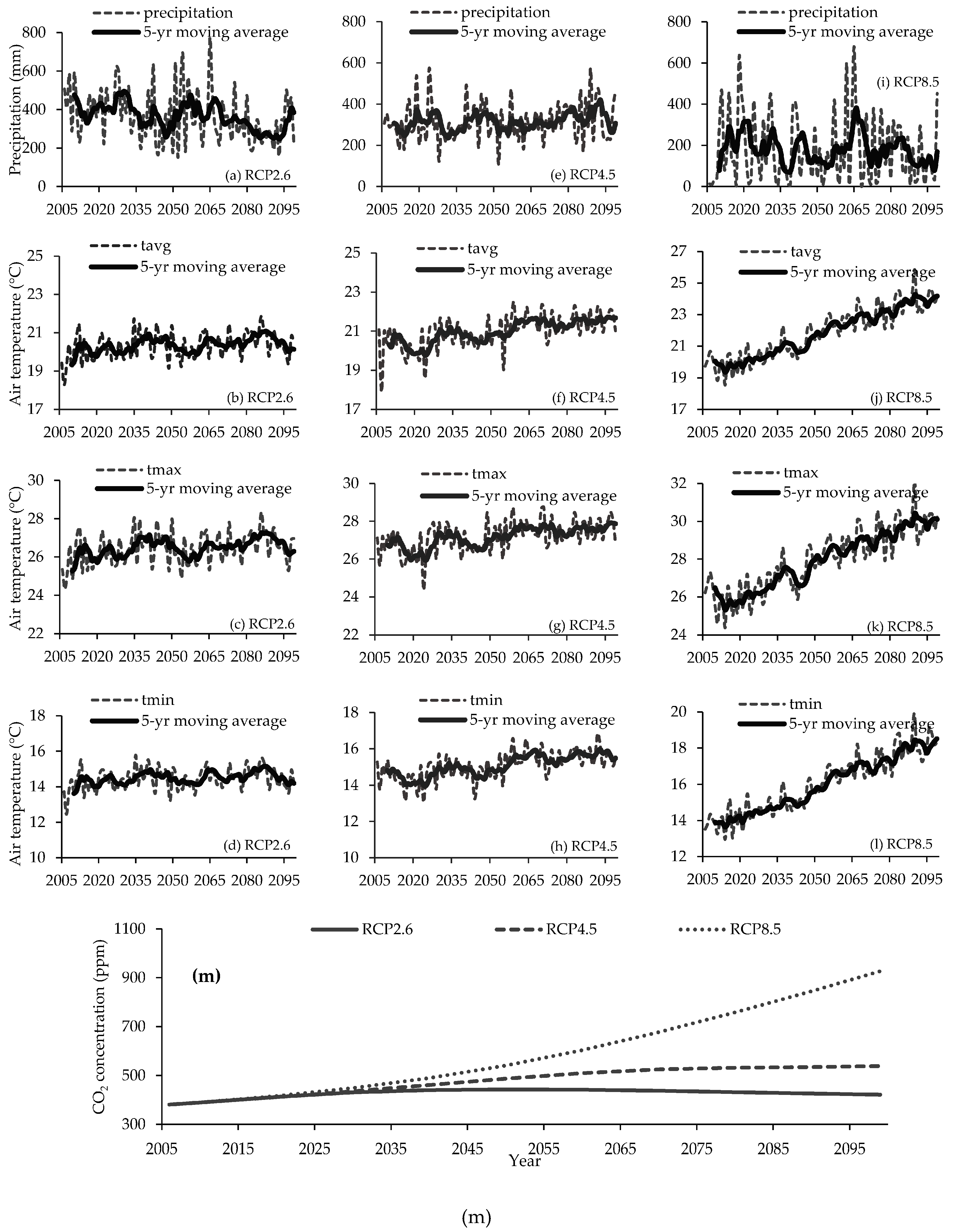
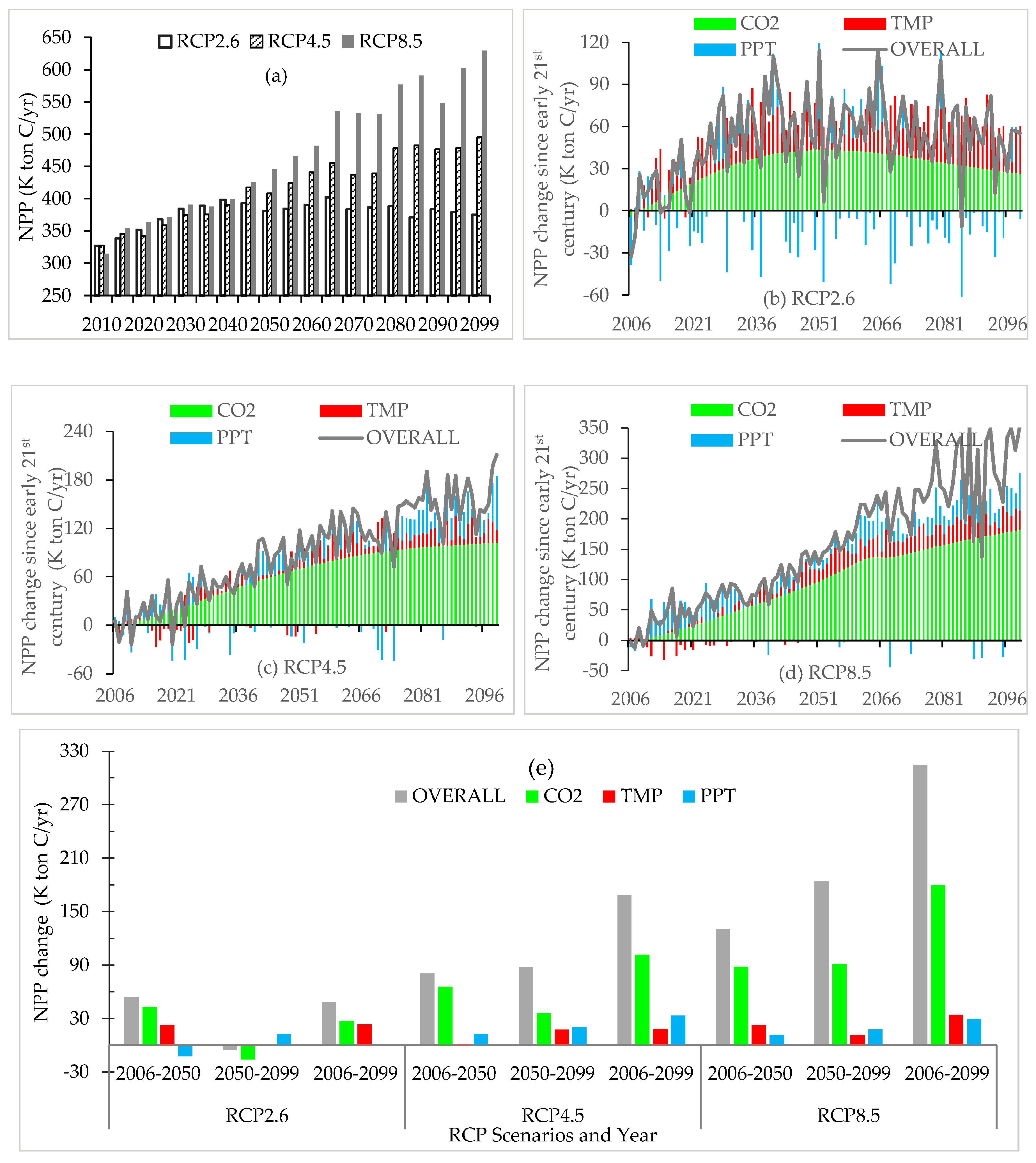
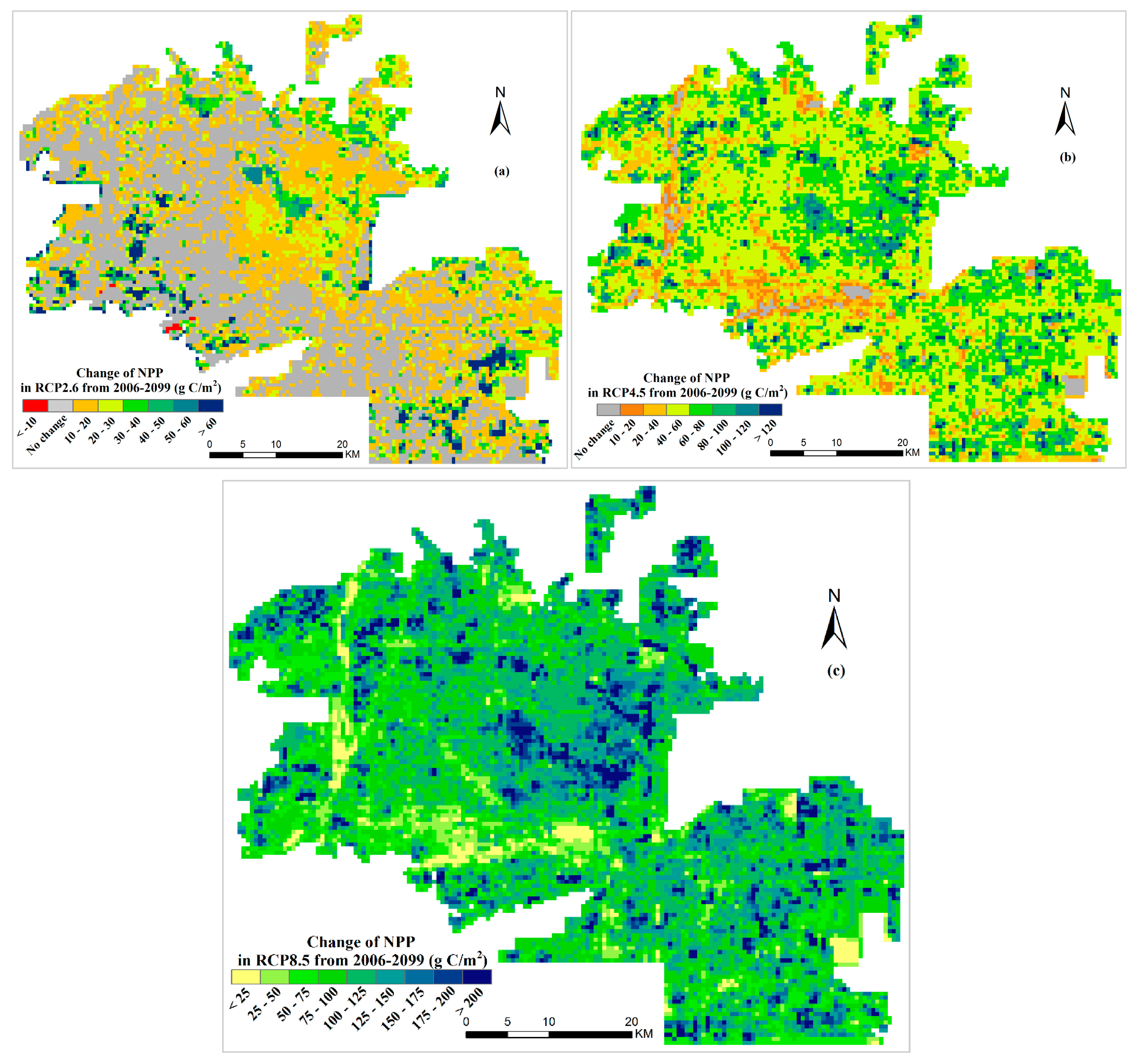
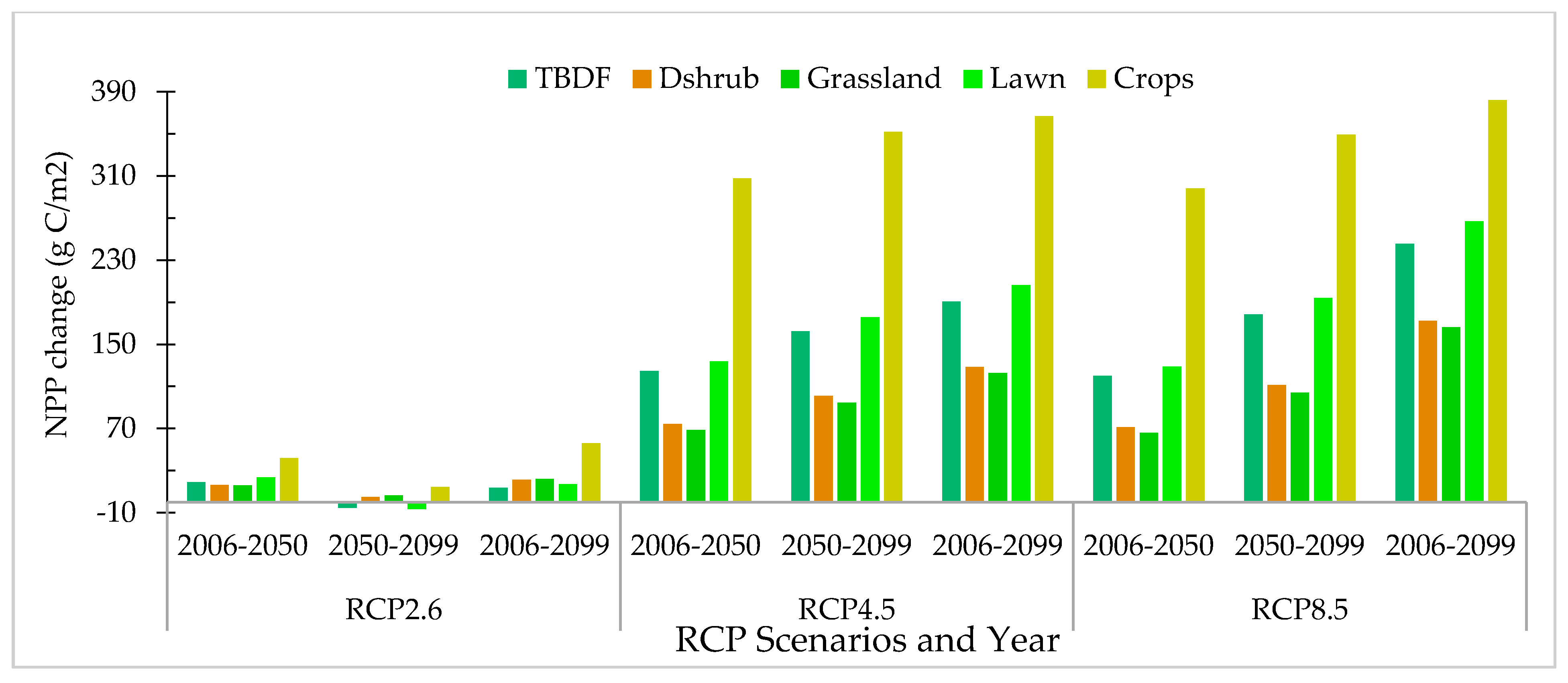
| CIMP5 GCM Products | Mean Air Temperature | Annual Precipitation | ||
|---|---|---|---|---|
| Correlation (R2) | Bias (°C) | Correlation (R2) | Bias (mm/Year) | |
| EC-EARTH Model | 0.79 | 5.18 | 0.48 | −230 |
| HadCM3 Model | 0.85 | 4.05 | 0.29 | −150 |
| CCSM4 | 0.86 | 9.48 | 0.72 | −234 |
| CanCM4 | 0.84 | 5.27 | 0.47 | −253 |
| GEOS-5 | 0.82 | 3.5 | 0.16 | −216 |
| MIROC5 Model | 0.78 | 4.08 | 0.38 | −169 |
| MPI-ESM-LR | 0.76 | 3.5 | 0.48 | −253 |
| MPI-ESM-MR | 0.85 | 2.91 | 0.64 | −81 |
| Land-Use Type | Area (km2) | Percentage (%) | Description |
|---|---|---|---|
| Commercial area | 137.54 | 4.74 | Commercial High-Community Retail/Regional Retail |
| Commercial Low-Amusement/Movie Theatre/Specialty Retail/Neighborhood Retail | |||
| Tourist Accommodations-Motel/Hotel/Resort | |||
| Business Park | |||
| Industrial area | 157.45 | 5.43 | Industrial |
| Other Employment-Landfill/Proving Grounds/Sand and Gravel/etc. | |||
| Residential (mesi and xeri) | 1372.6 | 47.3 | Single Family Medium Density-1 to 4 du/ac |
| Multi Family-Apartment/Condo | |||
| Single Family Low Density-Less than 1 du/ac | |||
| Single Family High Density-Greater than 4 du/ac-Includes Mobile Homes | |||
| Institutional area | 406.3 | 14 | Cemetery |
| Educational | |||
| Medical/Nursing Home | |||
| Mixed Use | |||
| Office | |||
| Public/Special Event/Military | |||
| Religious/Institutional | |||
| Transportation | 36.43 | 1.26 | Airport |
| Transportation | |||
| Waters | 52.75 | 1.82 | Water |
| Recreation area | 93.03 | 3.21 | Golf Course |
| Construction/transition | 39.36 | 1.36 | Developing Employment Generating |
| Developing Residential | |||
| Agricultural | 139.5 | 4.81 | Agriculture |
| Vacant natural | 467.04 | 16.09 | Vacant |
| Active Open Space | |||
| Passive/Restricted Open Space/Undevelopable |
| Mean Annual NPP (K Ton C/Year) | ||||
|---|---|---|---|---|
| RCP2.6 | RCP4.5 | RCP8.5 | ||
| Timeperiod | Early-21st century (2006–2010) | 327 | 327 | 315 |
| Mid-21st century (2048–2052) | 381 | 408 | 446 | |
| Late-21st century (2095–2099) | 376 | 495 | 629 | |
| NPP changes in the 1st half of the 21st century | Magnitude of the change | 54 | 81 | 131 |
| Change rate (%) | 16% | 25% | 41% | |
| NPP changes in the 2nd half of the 21st century | Magnitude of the change | −5 | 87 | 184 |
| Change rate (%) | −1% | 21% | 41% | |
| NPP changes in the 21st century | Magnitude of the change | 49 | 168 | 314 |
| Change rate (%) | 15% | 51% | 100% | |
| RCP2.6 | RCP4.5 | RCP8.5 | |||||||
|---|---|---|---|---|---|---|---|---|---|
| 2006–2050 | 2050–2099 | 2006–2099 | 2006–2050 | 2050–2099 | 2006–2099 | 2006–2050 | 2050–2099 | 2006–2099 | |
| OVERALL | 53.78 | −5.26 | 48.51 | 80.69 | 87.49 | 168.18 | 130.66 | 183.78 | 314.44 |
| CO2 | 42.78 | −15.76 | 27.03 | 65.86 | 35.97 | 101.82 | 88.24 | 91.16 | 179.4 |
| TMP | 23.14 | 0.65 | 23.78 | 1.07 | 17.46 | 18.53 | 22.92 | 11.34 | 34.26 |
| PPT | −12.19 | 12.46 | 0.27 | 12.8 | 20.44 | 33.23 | 11.78 | 17.79 | 29.57 |
| INTACTIVE | 0.04 | −2.61 | −2.57 | 0.97 | 13.62 | 14.59 | 7.72 | 63.49 | 71.21 |
| Ecosystem Type | Study Area | Methodology | β-Factor (1 SE) | Source |
|---|---|---|---|---|
| Grassland | Phoenix city, AZ, USA | Model simulation | 0.85 (0.26) | This study |
| central Colorado, USA | Open Top Chamber | 0.92–0.95 | Milchunas et al., 2005 [54] | |
| northwestern Switzerland | Screen aided CO2 control | 0.45 | Niklaus et al., 2001 [55] | |
| Minnesota, USA | FACE experiments | 0.52 | Reich et al., 2001 [56] | |
| Belgium | Open Top Chamber | 0.50 | Zavalloni et al., 2012 [57] | |
| Shrubland or desert | Phoenix city, AZ, USA | Model simulation | 0.79 (0.27) | This study |
| Nevada Desert FACE facility, southern Nevada, USA | Open Top Chamber | 1.68 (0.92) | Housman et al., 2006 [58] | |
| 1.31 | Smith et al., 2000 [59] | |||
| Global desert | Model simulation | 0.76–0.77 | Alexandrov et al., 2003 [51] | |
| Forest | Phoenix city, AZ, USA | Model simulation | 0.83 (0.31) | This study |
| Florida, USA | Open Top Chamber | 1.02–1.95 | Dijkstra et al., 2002 [60] | |
| Florida, USA | Open Top Chamber | 0.88–1.18 | Tognetti et al., 1999 [61] | |
| Belgium | Open Top Chamber | 0.72 | Jach et al., 2000 [62] | |
| Edinburgh, UK | Open Top Chamber | 0.84 | Rey et al., 1997 [63] | |
| Global forest | FACE experiments | 0.6 | Norby et al., 2005 [49] | |
| Cropland | Phoenix city, AZ, USA | Model simulation | 0.15–0.16 | This study |
| Netherlands | Open Top Chamber | 0.28 | Dijkstra et al., 1999 [64] | |
| Switzerland | FACE experiments | 0.1 (0.29) | Hebeisen et al., 1997 [65] | |
| Germany | FACE experiments | 0.37 | Högy et al., 2010 [66] |
© 2017 by the authors. Licensee MDPI, Basel, Switzerland. This article is an open access article distributed under the terms and conditions of the Creative Commons Attribution (CC BY) license (http://creativecommons.org/licenses/by/4.0/).
Share and Cite
Chen, C.; Zhang, C. Projecting the CO2 and Climatic Change Effects on the Net Primary Productivity of the Urban Ecosystems in Phoenix, AZ in the 21st Century under Multiple RCP (Representative Concentration Pathway) Scenarios. Sustainability 2017, 9, 1366. https://doi.org/10.3390/su9081366
Chen C, Zhang C. Projecting the CO2 and Climatic Change Effects on the Net Primary Productivity of the Urban Ecosystems in Phoenix, AZ in the 21st Century under Multiple RCP (Representative Concentration Pathway) Scenarios. Sustainability. 2017; 9(8):1366. https://doi.org/10.3390/su9081366
Chicago/Turabian StyleChen, Chunbo, and Chi Zhang. 2017. "Projecting the CO2 and Climatic Change Effects on the Net Primary Productivity of the Urban Ecosystems in Phoenix, AZ in the 21st Century under Multiple RCP (Representative Concentration Pathway) Scenarios" Sustainability 9, no. 8: 1366. https://doi.org/10.3390/su9081366




